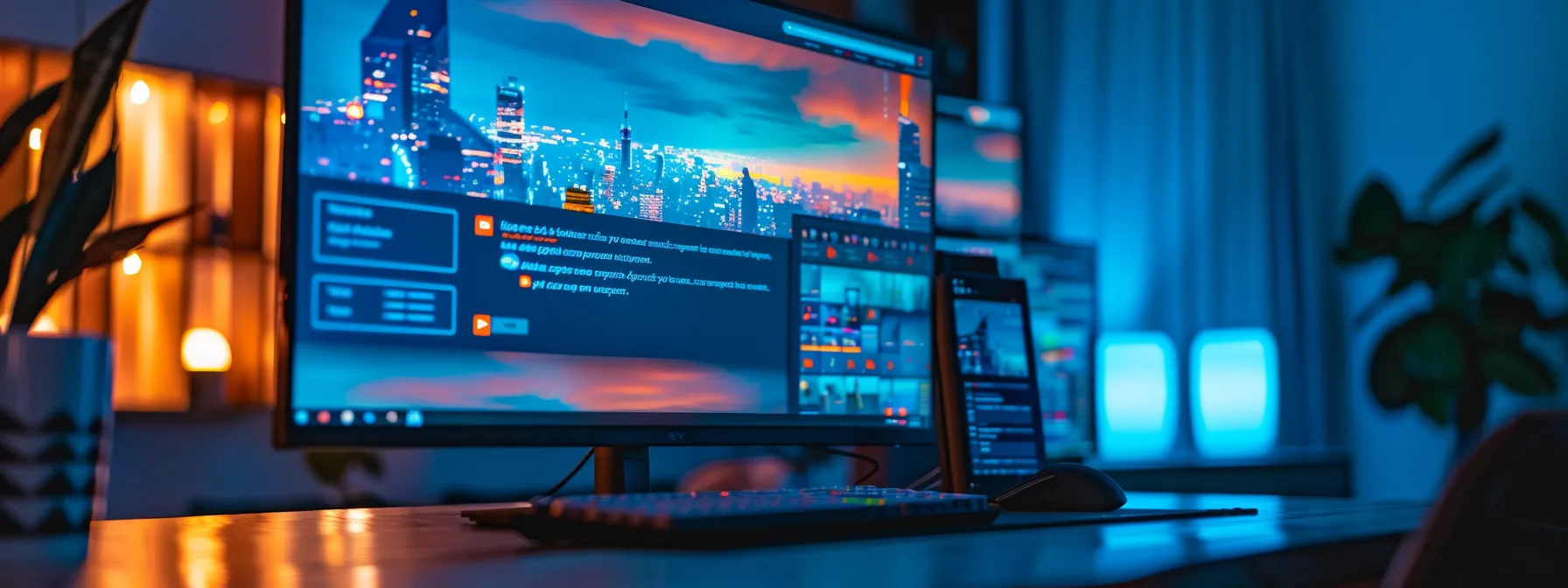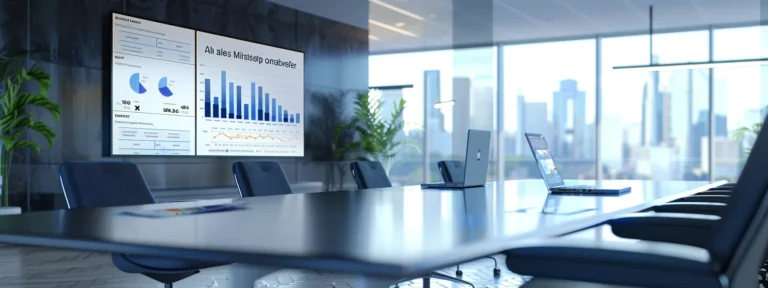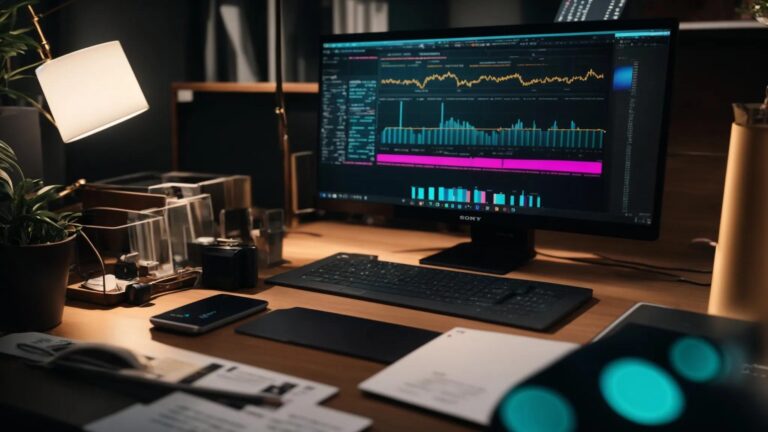Heads Up: When you purchase through links on our site, we may earn an affiliate commission at no cost to you.
Are you struggling to boost your site’s SEO? Many real estate investors overlook the importance of a strong internal linking strategy, which can significantly enhance the relevance and weight of your landing pages. In this article, you’ll learn about advanced techniques for internal linking, how to design an effective strategy, and best practices for content optimization. By implementing these strategies, you can improve your site’s search engine visibility and drive more traffic to your content. Let’s tackle the challenges of internal linking to elevate your SEO efforts and grow your real estate business.
Key Takeaways
- Internal links enhance navigation and improve SEO by signaling page importance to search engines
- Using descriptive anchor text boosts user clarity and supports effective internal linking strategies
- Regular audits of internal links help identify broken connections and optimize site performance
- Establishing a logical hierarchy facilitates user engagement and reduces bounce rates significantly
- Implementing topic clusters creates a structured approach that enhances content discoverability and SEO
Understanding Advanced Internal Linking and Its SEO Impact

Understanding the mechanics of internal links is crucial for boosting your site’s SEO. These links play a significant role in search algorithms, influencing your page rank and site architecture. While internal links differ from external links in their impact, many misconceptions can cloud their usage, such as the notion of cannibalization. This section will clarify these aspects and provide practical strategies using anchor text to enhance your site’s hierarchy.
The Mechanics of Internal Links in Search Algorithms
Internal links significantly influence how search engines evaluate your site’s content and structure. They provide clear pathways for search engine crawlers, helping them navigate your website efficiently. By implementing a well-structured silo approach, you enhance not only your site’s navigation but also its overall visibility in search results, which is essential for effective search engine optimization.
Each internal link you create serves as a signal to search engines about the importance of various pages on your site. Incorporating keyword-rich anchor text within these links reinforces theme relevance, guiding both users and search engines through your content hierarchy. This strategy helps you establish a coherent site structure, making it easier for potential customers to find the information they need:
- Utilize internal links to connect related content.
- Incorporate appropriate anchor text for clarity.
- Organize your content into silos for easier navigation.
- Regularly audit internal links to ensure they are effective.
Internal vs. External Links: Key Differences
Understanding the differences between internal and external links is essential for effective SEO strategies. Internal links, which connect different pages within your own website, help Googlebot navigate your site more efficiently, improving your overall site structure. On the other hand, external links point to websites outside of yours and can affect your site’s authority and trustworthiness, often analyzed through link analysis. Proper use of hyperlinks can establish relationships with external sources while maintaining a strong internal linking strategy to keep visitors on your site longer.
One key factor to consider is how each type of link influences visitor behavior, particularly bounce rate. Internal links, if used effectively, encourage users to explore related content, reducing bounce rates and increasing engagement. In contrast, external links may carry a nofollow attribute, signaling search engines not to pass on ranking power. Yet, they still contribute to your site’s credibility if linked to reputable sources. Balancing both types of links enhances your site’s SEO and provides a better user experience.
Addressing Common Misconceptions About Internal Linking
One common misconception among webmasters is that internal linking primarily serves to create backlinks within their own site. While it’s true that internal links can facilitate site navigation, their real value lies in improving user experience and content discoverability. By using a well-structured table of contents or clearly defined anchor text within your HTML element, you can guide visitors directly to the content they are looking for, promoting effective content marketing strategies.
Another misunderstanding is that too many internal links on a web page can lead to confusion or a diluted impact on SEO. In reality, a strategic approach to internal linking can enhance your SEO efforts by clarifying your site’s hierarchy and guiding search engines effectively. For instance, linking relevant articles strengthens topical relevance and reinforces the relationship between different pieces of content, helping search engines determine the structure and priorities of your website:
| Misconception | Clarification |
|---|---|
| Internal links only create backlinks. | They enhance user navigation and improve content discoverability. |
| Too many internal links harm SEO. | Strategic links clarify site hierarchy and reinforce content relevance. |
Designing an Effective Internal Linking Strategy

To design an effective internal linking strategy, start by evaluating your current link structure to identify opportunities for improvement. Organizing your content with a logical pyramid hierarchy ensures that important pages are easily accessible. Implementing topic clusters will enhance navigation and user experience, aligning with your marketing strategy. Lastly, utilize tools for keyword research to plan and optimize your internal links, keeping search algorithm criteria in mind.
Evaluating Your Current Link Structure
To evaluate your current link structure effectively, begin by analyzing your site’s internal links using analytics tools. Identify key performance indicators to assess the health of your site’s navigation, paying special attention to pages with excessive internal links that could lead to keyword stuffing. This approach helps pinpoint areas with potential duplicate content, ensuring that each page retains its unique value and link juice while enhancing user experience.
Next, consider how your internal links contribute to the overall hierarchy of your website. Ensure all important pages are easily accessible through logical pathways. Utilize the alt attribute in your images as an added opportunity to create relevant internal links, and make adjustments based on user behavior and engagement metrics. This will help you foster a robust internal linking strategy that aligns with your SEO goals:
- Analyze the current internal link performance with analytics tools.
- Identify pages with excessive links to avoid keyword stuffing.
- Ensure a clear hierarchy to enhance navigation.
- Utilize the alt attribute to create internal links.
Organizing Content With a Logical Hierarchy
Organizing your content with a logical hierarchy is essential for effective link building and improving your site’s SEO. By structuring your pages to create a clear navigation path, you can enhance user experience and make it easier for search engines to crawl your site. This is particularly important when dealing with subdomains, as you should ensure that each section maintains its relevance and connection to the main domain to optimize your backlink strategy and overall site authority.
Implementing well-defined sitemaps is another practical approach to organizing your content logically. By creating a comprehensive roadmap of your website, you help both visitors and search engines quickly find important pages. Utilizing tools like Google’s Search Central can assist you in monitoring your internal linking structure, enabling you to make adjustments that facilitate better rankings and visibility. This strategic organization not only aids in enhancing user engagement but also contributes to building authority and trust with search engines.
Implementing Topic Clusters for Better Navigation
Implementing topic clusters is a powerful strategy that enhances usability on your site by organizing related content into clear, interconnected sections. This approach not only improves navigation for your visitors but also signals to search engines that your content is thorough and well-structured. By grouping articles around a core topic, you can effectively convey your expertise in the real estate investment niche, which is essential for those seeking to boost their SEO through rei seo services.
When you utilize topic clusters, you create a natural path for users to explore your website, reducing bounce rates and increasing engagement. For instance, if you’re focused on real estate investment tips, you can develop a pillar page that links to several subtopics, providing comprehensive resources that keep readers on your site longer. Additionally, using tools for investors to analyze the performance of these clusters can further refine your strategy, ensuring your efforts are effective and aligned with user intent.
Utilizing Tools for Planning Internal Links
Using planning tools is essential for effectively structuring your internal links to enhance SEO. Tools like Screaming Frog or Ahrefs can help you analyze your existing internal link structure, identifying opportunities to connect related content. By visualizing your site’s architecture, you can pinpoint gaps and improve your linking strategy, ensuring that important pages receive adequate support and visibility.
Additionally, content management systems (CMS) often offer built-in features that assist in planning and maintaining internal links. For example, using a tool like WordPress allows you to easily create and manage links within your posts, enhancing user experience and engagement. By strategically planning your internal links, you create a more navigable site that not only supports SEO goals but also meets the needs of your visitors.
- Instant feedback
- Valuable insights
- Actionable tips
Advanced Techniques for Internal Linking

Connecting orphan pages is vital for increasing their visibility, while optimizing anchor text enhances relevance and readability. Seamlessly incorporating contextual links within your content will improve user experience, and strategically highlighting priority pages ensures search engine crawlers recognize your most important content. These advanced techniques will elevate your internal linking strategy, leading to better SEO performance.
Connecting Orphan Pages to Increase Visibility
Connecting orphan pages is essential for enhancing your site’s SEO and increasing its visibility. Orphan pages are those that do not receive any internal links, making it difficult for search engines and users to find them. By integrating these pages into your site’s internal linking structure, you improve their accessibility, helping search engines recognize their relevance and increasing the chances that users will discover them.
To effectively link orphan pages, start by identifying content that lacks internal connections. Once you locate these pages, strategically place links within relevant articles or sections of your site. This approach not only boosts the visibility of the orphan content but also enriches the user experience by offering more comprehensive information on related topics. By ensuring that these pages are connected, you maximize their potential to contribute to your overall SEO strategy.
Optimizing Anchor Text for Relevance
Optimizing anchor text plays a crucial role in enhancing your site’s SEO through internal linking strategies. When you use descriptive, keyword-rich anchor text, you not only provide context for readers but also signal to search engines the relevance of the linked page. For example, if you have a page about property investment tips, linking phrases like “learn about property investment” can significantly improve the linked page’s visibility in search results.
Additionally, maintaining a natural flow while optimizing anchor text is essential for user experience. Avoid over-stuffing keywords; instead, focus on creating clear and informative links that guide visitors through your site. This approach encourages users to explore more content, ultimately reducing bounce rates and improving engagement. By strategically optimizing your anchor text, you create a seamless navigation experience that enhances both user satisfaction and your site’s SEO performance.
Incorporating Contextual Links Seamlessly
Incorporating contextual links seamlessly within your content not only enhances user experience but also strengthens your SEO efforts. When you weave links naturally into relevant sections of your text, you provide clear pathways for readers to access related information without disrupting the flow. For instance, if discussing real estate investment strategies, linking to a guide on market analysis creates a cohesive reading experience that encourages deeper engagement with your site.
To optimize your internal linking strategy, focus on relevance and clarity in your contextual links. Use descriptive anchor text that accurately reflects the linked page’s content, making it easy for users to understand what to expect. This approach not only aids in improving your site’s structure but also supports search engines in identifying the context of each page, thereby enhancing your overall SEO performance. Consider the following steps for effective contextual linking:
- Create meaningful connections between related topics.
- Use descriptive and relevant anchor text.
- Avoid disrupting the reading flow with excessive links.
Highlighting Priority Pages Through Strategic Links
Strategically highlighting priority pages is essential for guiding visitors and search engines to your most important content. By utilizing internal links that emphasize these key pages, you prioritize their visibility and relevance within your site’s structure. For example, if you have a leading article on investment strategies, linking to it from various related posts reinforces its significance and helps it rank higher in search results.
To effectively highlight priority pages, consider where your audience is most likely to engage with your content. Place internal links prominently within your posts, using relevant anchor text that clearly indicates what users will find. This method not only boosts user engagement by providing easy access to valuable information but also signals to search engines which pages hold more authority, ultimately enhancing your overall SEO strategy.
Best Practices for Content Optimization via Internal Links

Focus on several best practices to optimize your site’s content effectively through internal links. First, ensure your links are crawlable by search engines, allowing them to discover your content easily. Next, manage the quantity of links on each page to maintain clarity and effectiveness, avoiding over-optimization and link dilution. Regular audits of internal links will help you identify any issues and ensure optimal performance, enhancing your overall SEO strategy.
Ensuring Links Are Crawlable by Search Engines
To ensure your internal links are crawlable by search engines, you must focus on a clean link structure and proper HTML markup. Using standard HTML tags without redirects or complex JavaScript helps search engine bots access your content efficiently. Regularly validating your site’s structure with tools like Google Search Console will help you identify any crawl errors that could hinder search engines from indexing your valuable pages.
It’s also important to avoid using “nofollow” attributes on your internal links unless necessary. When you mark a link as nofollow, you instruct search engines not to follow that link, potentially restricting the flow of link equity throughout your site. By prioritizing standard, crawlable links, you enhance your site’s SEO and help search engines better understand your content hierarchy, leading to improved visibility in search results.
Managing Link Quantity on Each Page
Managing the quantity of internal links on each page is essential for effective SEO and user experience. You want to strike a balance that allows search engines to recognize important content without leading to information overload or confusion for your visitors. A well-managed internal linking structure enables users to navigate your site easily, promotes content discoverability, and reduces the risk of keyword stuffing.
As a best practice, aim for a targeted number of internal links per page based on the content’s length and relevance. For instance, a comprehensive article might benefit from 5 to 10 internal links, while a shorter post may only need 2 to 3 links to related topics. This strategy helps maintain clarity and guides users to valuable information effectively, ensuring a better experience on your site:
- Aim for a balance in link quantity.
- Target 5 to 10 links for longer content.
- Use 2 to 3 links for shorter articles.
- Maintain user experience and clarity.
Avoiding Over-Optimization and Link Dilution
Avoiding overoptimization and link dilution is crucial for maintaining your site’s SEO performance. Overcrowding your pages with internal links can create confusion for users and diminish the value of each link you include. Aim to strike a balance by incorporating a sensible number of internal links that guide users effectively without overwhelming them with options.
An effective strategy is to focus on linking only to relevant content that enhances the reader’s experience. For instance, if you provide a comprehensive article on real estate market trends, link to related articles on investment strategies or property management. This targeted approach not only maintains clarity but also reinforces the contextual relevance of your internal links, boosting your site’s overall SEO power.
Conducting Regular Audits of Internal Links
Conducting regular audits of your internal links is essential for maintaining an effective SEO strategy. These audits help you identify broken links, outdated content, and opportunities for improvement. By effectively tracking your internal linking structure, you ensure that users can easily navigate your site, enhancing their experience and keeping search engines happy.
Using tools like Google Search Console, you can analyze your internal links and assess their performance continually. This proactive approach allows you to make necessary adjustments—such as updating anchor text or optimizing link placements—to enhance your site’s hierarchy. Ultimately, regular audits not only boost your site’s SEO but also directly address visitor concerns, promoting a more engaging user experience.
Real-World Examples of Successful Internal Linking

In this section, you’ll analyze the link structures of top-ranking websites to see what makes their internal linking strategies effective. You’ll also learn from common internal linking mistakes that can hinder SEO performance. Finally, measuring SEO improvements from strategic linking will offer practical insights on how to enhance your own site’s visibility and authority.
Analyzing Link Structures of Top-Ranking Websites
When you analyze the link structures of top-ranking websites, you’ll notice that they often employ a strategic approach to internal linking that enhances overall site navigation and user experience. These sites typically create a well-defined hierarchy that clearly links related content, allowing both users and search engines to access information easily. For instance, a real estate investment site may link its articles on property valuations to relevant market trend analyses, guiding readers through interconnected topics that keep them engaged longer.
By examining successful examples, you can identify best practices for your internal linking strategy. High-ranking websites effectively use descriptive anchor text that not only boosts their SEO but also improves user clarity regarding linked content. Recognizing these techniques can empower you to implement similar strategies, helping enhance your site’s visibility in search results and improving the overall user experience for your audience.
Learning From Common Internal Linking Mistakes
One common internal linking mistake is using ambiguous anchor text that does not clearly describe the linked content. When you replace generic terms like “click here” with descriptive phrases related to the content, you improve user experience and enhance SEO. For example, linking to a specific article on property management strategies using the anchor text “property management tips” provides clarity and relevance, making it easier for visitors to understand what they can expect from the link.
Another mistake is failing to regularly audit your internal links, which can result in outdated or broken connections. Neglecting this task can lead to a poor user experience and missed opportunities for SEO benefits. Implementing routine audits allows you to identify and fix these issues, ensuring that your site remains engaging and valuable, which ultimately supports your overall SEO goals.
Measuring SEO Improvements From Strategic Linking
Measuring SEO improvements from strategic internal linking involves tracking key performance indicators like organic traffic, bounce rates, and page rankings to assess the effectiveness of your linking strategy. For instance, after implementing a structured internal linking system, you may notice an increase in visits to pages that were previously less visible. This data provides insights into how well your links guide users through your content, reinforcing their value to both your audience and search engines.
In addition to quantitative metrics, qualitative feedback is also essential for measuring improvements. Engaging user behavior, such as time spent on the site and interaction with linked content, offers a clear picture of how your internal linking enhances the user experience. By continuously monitoring these metrics, you can refine your strategy, ensuring that every link serves its purpose and contributes to your overall SEO growth.
Implementing Advanced Internal Linking for SEO Enhancement

To enhance your site’s SEO through advanced internal linking strategies, start by developing a step-by-step action plan to implement effective linking techniques. After implementation, monitoring SEO metrics will help you gauge the impact of your efforts. Lastly, keeping up with internal linking best practices ensures your strategies remain relevant, driving sustained improvement in your search visibility.
Developing a Step-by-Step Action Plan
To develop an effective step-by-step action plan for advanced internal linking, start by auditing your existing website structure. Analyze the current linking patterns using tools like Google Search Console or Screaming Frog to identify areas where internal links can be added or improved. This initial assessment helps pinpoint orphan pages and underlinked content, which are critical for optimizing your site’s SEO performance.
Next, prioritize your key content based on its strategic importance and relevance. Create a visual map of how your pages should connect, focusing on using descriptive, keyword-rich anchor text to guide both users and search engines. By following this structured approach, you establish a clear linking framework that enhances user navigation and significantly boosts your SEO efforts:
- Audit your current internal linking structure.
- Identify orphan pages and opportunities for improvement.
- Prioritize key content and create a visual linking map.
- Use descriptive, keyword-rich anchor text in your links.
Monitoring SEO Metrics After Implementation
After implementing advanced internal linking strategies, it’s crucial to monitor SEO metrics to assess the impact of your changes. Focus on tracking key performance indicators such as organic traffic, bounce rates, and average session duration. By regularly reviewing these metrics, you can identify trends that indicate whether your internal linking efforts are effectively guiding users to related content and enhancing their overall experience.
Additionally, consider using tools like Google Analytics or SEMrush to gain insights into user behavior and engagement with linked content. For example, if you notice a significant increase in traffic to pages with newly added internal links, it’s a strong indication that your strategy is working. Continuously adjusting your internal linking based on these observations will help you maintain and improve your site’s SEO performance over time.
Keeping Up With Internal Linking Best Practices
Keeping up with internal linking best practices is vital for maximizing your site’s SEO performance. Regularly review and update your internal links to ensure they remain relevant as you add new content. This can help prevent the decline in visibility for older pages that may be overlooked without proper linking. Utilize tools that analyze your internal link structure to identify gaps or opportunities where new links could enhance user navigation and engagement.
Moreover, focus on creating a consistent linking strategy that uses descriptive anchor text. This not only helps search engines understand the context of linked pages but also guides users to valuable content. By incorporating these practices, you can enhance the user experience on your site while effectively improving your organic search rankings. Here’s a summary of best practices for internal linking:
| Best Practice | Description |
|---|---|
| Regular Link Audits | Review and update your internal links frequently to maintain relevance. |
| Descriptive Anchor Text | Use clear phrases that accurately describe the linked content. |
| Utilize Analytics Tools | Analyze the performance of your links to find improvement opportunities. |
Conclusion
Advanced internal linking strategies are crucial for enhancing your site’s SEO and improving user experience. By effectively connecting related content, you not only guide search engine crawlers but also keep visitors engaged longer. Prioritizing descriptive anchor text and regularly auditing your links can significantly boost your site’s visibility and authority. Implementing these strategies will ultimately lead to better search rankings and a more navigable site for your audience.















